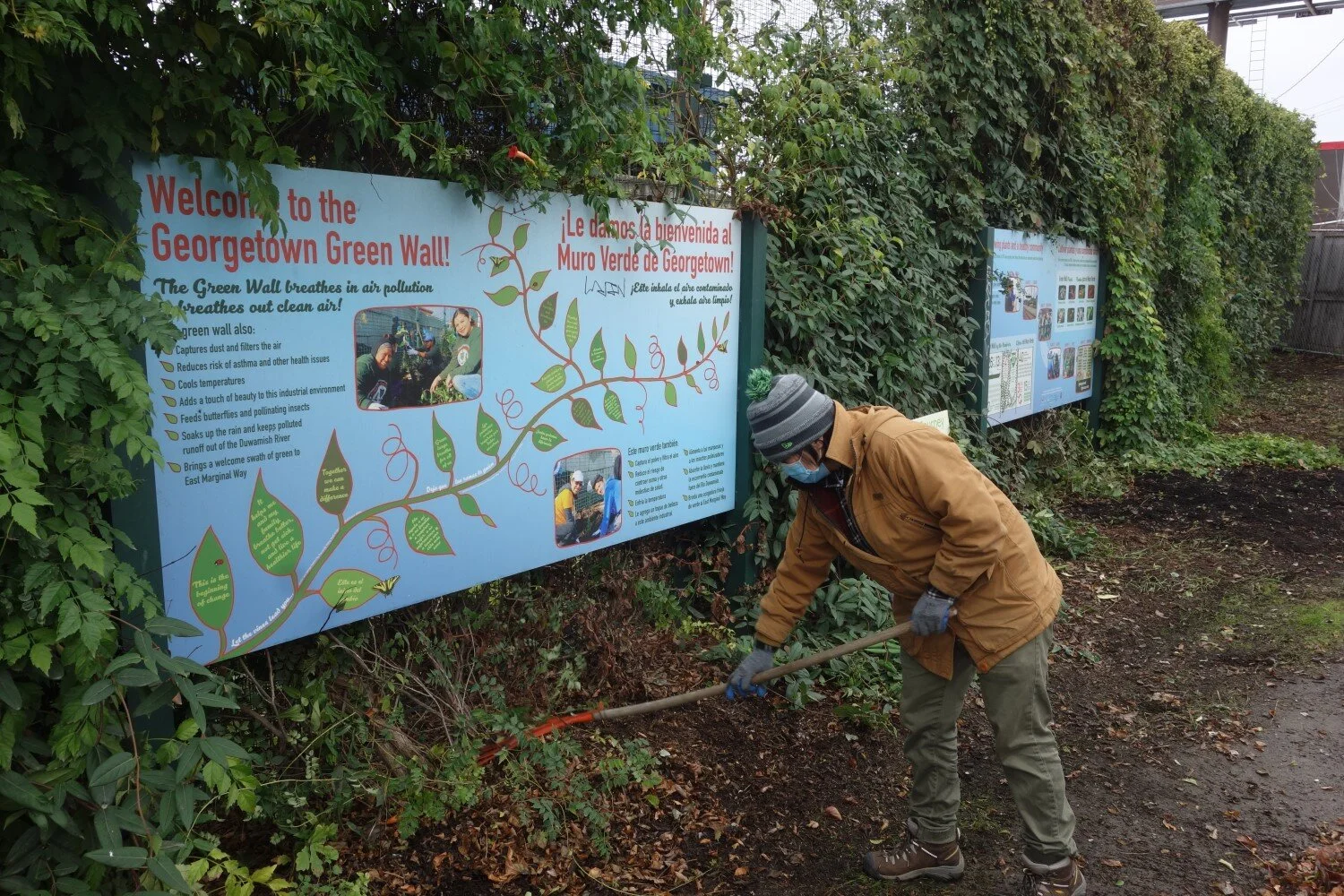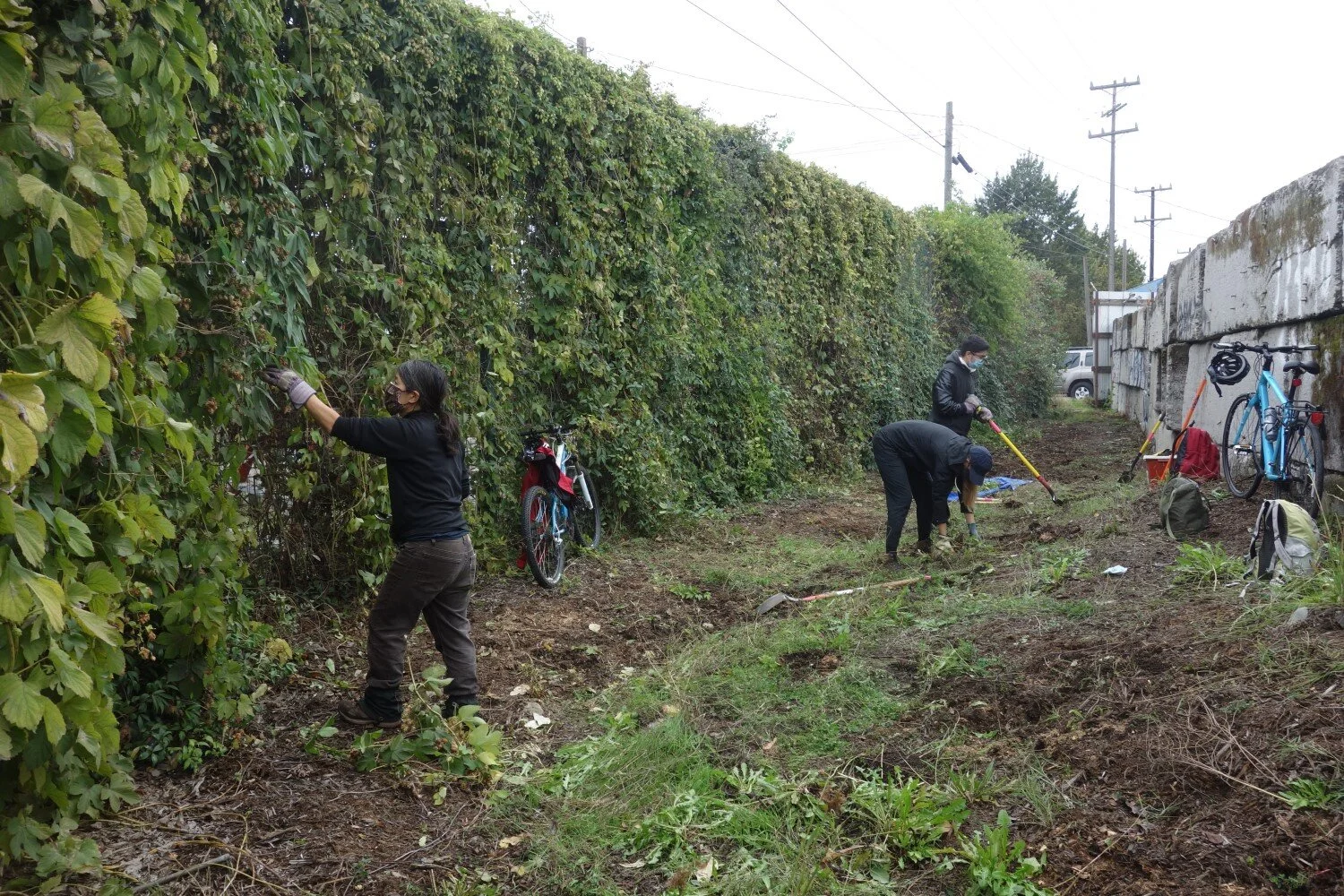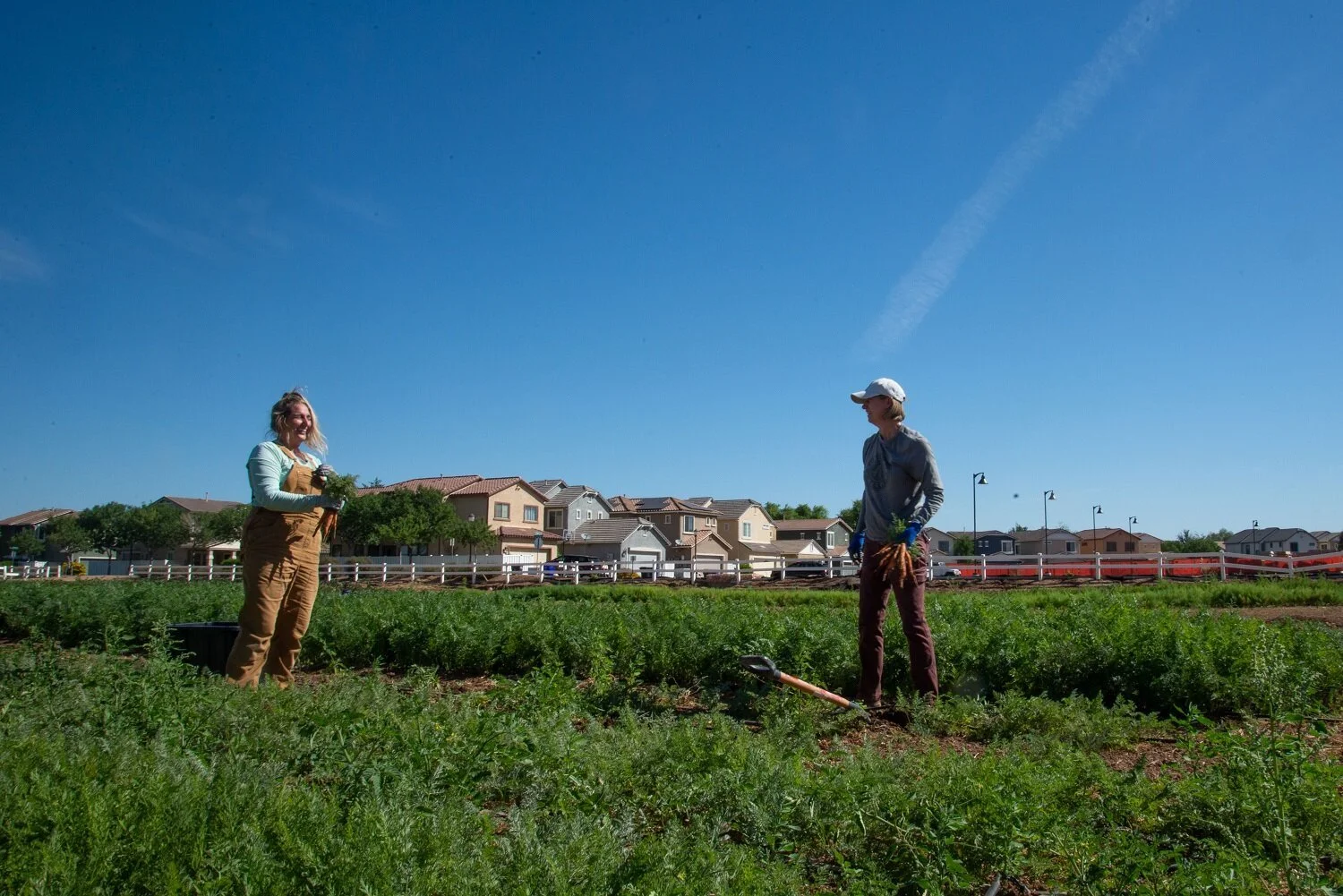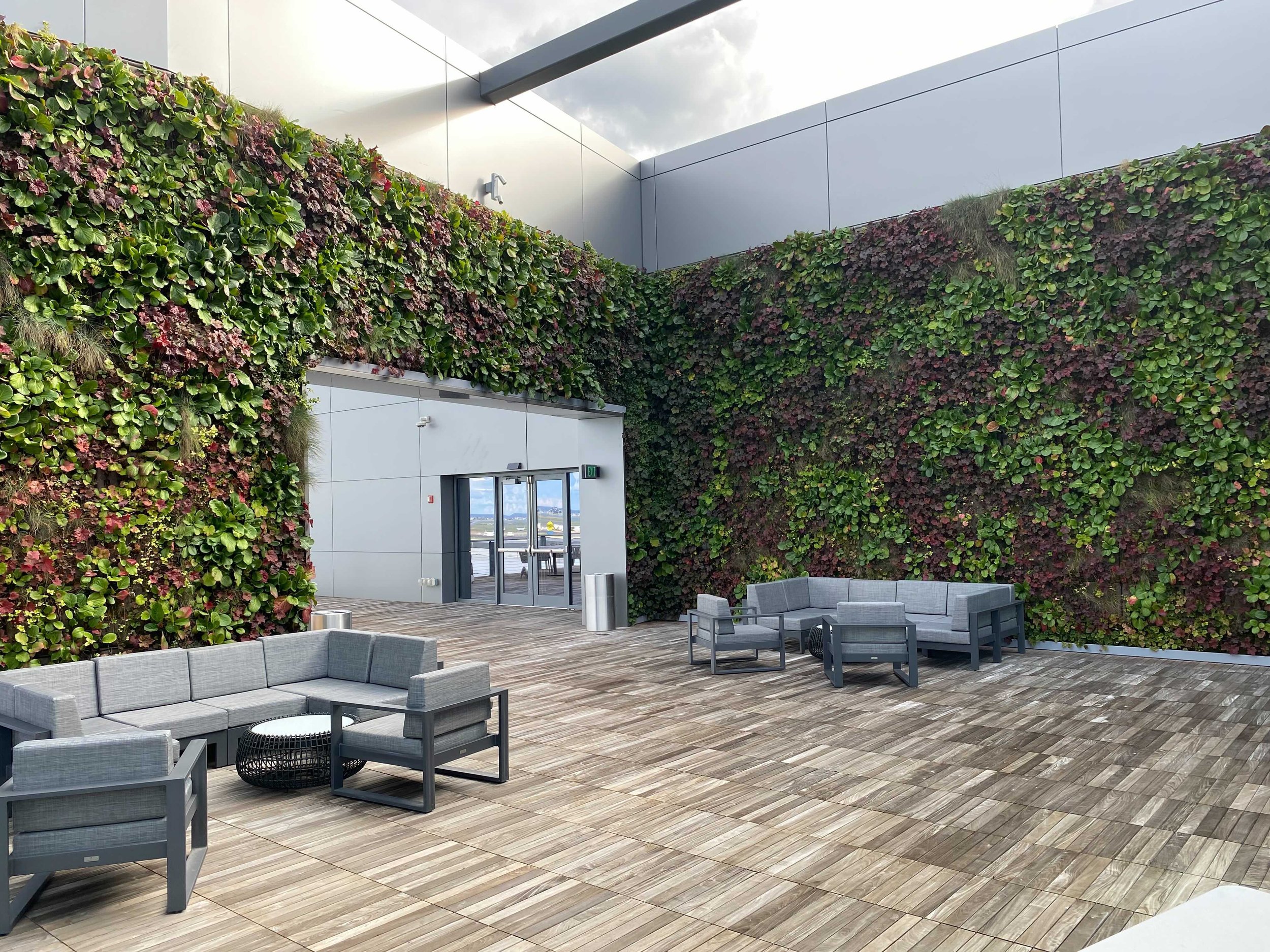“My Neighborhood Is Killing Me” – A Seattle Green Wall is Raised in Hope
Advertisement
“If we talk about the environment, for example, we have to talk about environmental racism – about the fact that kids in South Central Los Angeles have a third of the lung capacity of kids in Santa Monica”
The Crew of DIRT Corps Volunteers who installed and maintain the Georgetown Green Wall; (l-r): Chelsea Kyger, Andrew Schiffer, Frances Meger, Jackie Bannister, Iona Park. Photo: Linn Gould, Just Health Action
The Environmental Justice Movement in the USA
Protests, demonstrations, marches and sit-ins against unwanted land uses, exposure to toxic chemicals by industrial and commercial uses are sadly nothing new. Communities urban and rural have cried out for environmental protection with social justice for decades, but their protests were considered isolated and not associated with other communities in similar situations. In the 60’s, Cesar Chavez’ Farm workers organized for workplace rights and protection from harmful pesticides in the fields and orchards of California, but not until the early 1980's did the movement become one of national, social and racial protest.
In 1982, Afton, a small, predominantly African-American community in Warren county was designated as the site of a hazardous waste landfill that accepted PCB-contaminated soil from illegal dumping of toxic waste along roadways. The National Association for the Advancement of Colored People (NAACP) and others staged a massive protest. More than 500 people were arrested, including a Minister of the United Church of Christ and a member of the US Congress. The protest didn’t prevent the siting of the disposal facility, but the issue became national news, and set the stage for the Environmental Justice movement. To civil rights activists looking on as the events in Warren County played out, the action of the North Carolina state government in forcing a toxic landfill onto a small African-American community was a familiar expression of the racism they had encountered for decades in housing, education and employment. Only this time, it was environmental racism.
Protestors in Afton, NC in 1982. Photo: Rick Stilley
In the 1980’s, several studies concluded that, regardless of motivation, race was the most significant factor in siting these facilities, and that three out of every five African Americans and Hispanics live in communities housing toxic waste sites. Minority communities felt that they had been targeted for unwanted land uses and had little, if any, power to remedy their situation. This growing awareness led to the First National People of Color Environmental Leadership summit. A consensus document that set out the principles of environmental justice was drafted. In 1992 President George Bush Sr. engaged the Environmental Protection Agency (EPA) to establish an Environmental Equity Working Group to initiate meetings with community leaders on environmental justice issues and to seek solutions.
In 1994, President Clinton signed Executive Order 12898, key legislation that mandated the EPA to set standards, issue permits, award grants, issue licenses, provide regulations and review proposed actions by other federal agencies. Under EO # 12898, federal agencies are directed to develop environmental justice strategies to help address disproportionately high and adverse human health or environmental effects of their programs on minority and low-income populations. Since then, EO 12898 has been the mechanism through which Environmental Justice (EJ ) can be delivered where discrimination and racism have affected the health of communities in the US.
“My Neighborhood is Killing Me”
“I felt like I had to take a running start to breathe,” said homeowner Kelly Welker of Georgetown, a mostly industrial area on the Duwamish River in South Seattle, in the Seattle Weekly speaking of her 2015 experience at the time. Residents’ eyes were burning. A chalky, caustic dust billowed through the air, settling on their homes, stinging their noses and throats, and causing piercing headaches, nosebleeds, and in some cases asthma attacks.
Advertisement
Almost all of Georgetown, and the Duwamish River Valley in South Seattle, is zoned industrial; Five miles of the Lower Duwamish River itself is now a multimillion-dollar Superfund site whose resident fish are too toxic to consume, and the slim rectangle of family homes in the Georgetown neighborhood are flanked by industrial facilities and freight-train tracks and diesel trucks that regularly cough out all sorts of fumes and particulates. So the burning throats of spring 2015 were hardly the first health impacts for local residents—and likely weren’t the last. In 2015, after residents’ complaints, and the city’s response, this particular toxic-dust culprit—a construction-debris-recycling facility called CDL Recycle—temporarily closed its Georgetown location.
DIRT Corps Volunteer Jackie Bannister helps maintain the green wall. Photo: Linn Gould, Just Health Action
For years, the Duwamish River Cleanup Coalition/Technical Advisory Group (DRCC/TAG) has been working to improve the environment and health of the Duwamish Valley community. In 2013, DRCC/TAG received an EPA grant to conduct a Cumulative Health Impacts Analysis (CHIA) to document and quantify the Valley’s environmental health status relative to other areas of Seattle. Cumulative impacts are defined as: “any exposures, public health or environmental effects from the combined emissions and discharges, in a geographic area, including environmental pollution, from all sources, whether single or multimedia, routinely, accidentally or otherwise released” (OEHHA, 2010). Just Health Action (JHA), a Seattle-based non-profit that advocates for reducing health inequities resulting from social, political, environmental and economic conditions collaborated with DRCC to co-author the document. JHA and DRCC showed the Duwamish Valley is disproportionately impacted by environmental contamination and has less resources than the rest of Seattle. The CHIA showed a 13-year shorter life expectancy for Duwamish Valley residents, relative to that for residents of wealthier and adjacent neighborhoods, and the childhood asthma hospitalization rates for childhood asthma, at the time the highest in the City. The primary analysis also showed that air quality was one of the most pressing environmental issues. DRCC then received an EPA Collaborative Problem Solving Agreement to address air pollution.
Key Facts
Year: 2016
Size: 1638 sq. ft. (126’ x 13’)
System: greenscreen® powder-coated, welded steel, 3-dimensional trellis
Cost: $93,000
Plants: 60+ vines of Climatis, Honeysuckle, Hydrangea, and Virginia Creeper
Irrigation: Drip irrigation, in dry season only
Installation: 13 groups and over 40 volunteers involved
Green wall installations are often considered as site-specific solutions for a variety of environmental conditions, such as trapping airborne dust and particulates, buffering sound, providing shade and cooling proximal temperatures, making bio-habitat ‘corridors’ for displaced birds and insects, enabling pollination and a range of biophilic attributes. However, green walls are seldom the result of a community based participatory, research-driven process and strategy whose goal is equitable access to effective protection from explicit environmental health hazards and a healthy environment. As part of DRCC’s Clean Air Program to address the communities’ concerns about the air pollution issues in Georgetown and South Park, JHA researched solutions across the country and found three good options: green walls, street tree planting, and strategic coordination of upcoming “greening” projects. Using a community participatory decision making approach, JHA and DRCC asked the the community what they wanted. “The community chose the green wall concept,” says Executive Director, Linn Gould of JHA. “Green walls seemed like a unique approach. The community then chose CDL Recycle as the best location for a green wall to help control dust, and CDL agreed to collaborate on the project.”
“When the Georgetown green wall fills in to maximum lushness, it will become a living, breathing member of the community, filtering dust from industrial activities to help protect the eyes and lungs of nearby residents”
Permitting a freestanding green wall presented the next hurdle. The wall is located by a railroad track and busy arterial roadway, where safety is a concern for the City of Seattle. The wall design would need to be robust enough to stay upright in high winds and other natural conditions. Project organizers struggled through three rounds of permitting as the size of the concrete footings grew larger and more expensive each round. King County Wastewater Treatment Division (WTD) provided $70,000 through a Green Grant to JHA for outreach, materials, and construction. CDL Recycle contributed labor and heavy equipment that JHA Executive Director Linn Gould says was worth about $30,000 in matching funds, and “critical to success.” Andrew Schiffer, co-owner of DIRT Corps, and a Georgetown resident partnered with JHA to install the Green Wall. Both DIRT Corps and Duwamish Valley Youth Corps and were trained and provided labor which builds job skills and resumes. Local companies donated materials.
Advertisement
The green wall under construction, featuring a powder-coated, welded steel, 3-dimensional trellis. Photo: greenscreen®
In Georgetown, the largest freestanding Green Wall in the Seattle area stands as a banner to community health in action. It hides an ugly, concrete barrier at CDL Recycle on East Marginal Way. The Green Wall is not only a successful, sustainable structured landscape ‘intervention’ in its inherent functionality, but delivers benefits that satisfy the goals articulated in the owner’s participatory design process. The owner, the Community of the Duwamish Valley, its partners, JHA, the Duwamish River Cleanup Coalition, DIRT Corps and the Duwamish Valley Youth Corps installed the 126’ by 13’ high green wall trellis in 2016.
The powder-coated, welded steel, 3-dimensional trellis panels support a tapestry of vine species such as Climatis, Honeysuckle, Hydrangea, and Virginia Creeper, irrigated by a drip system in the dry season only. The flourishing vegetation delivers environmental services like the ability to help mitigate air pollution and create diverse, habitat for birds and insects on an aesthetically pleasing structure, independent of a building and located where trees cannot be planted.
The Green Wall is the culmination of years of effort by neighbors, groups, organizations, and business people. In a project overview of their learning experience, the owners expressed their satisfaction: “The community response and tangible benefits make the project well worth doing despite any and all challenges”.
DIRT Corps volunteers maintain the green wall in 2020. Photo: Linn Gould, Just Health Action
The Duwamish green wall demonstrates that the will and the means for environmental protection can be harnessed by community action, and environmental justice can be done. Since then, DIRT Corps and JHA have built one more green wall in Georgetown and two green walls in neighboring South Park. Continuing to green the Duwamish Valley in order to reduce air pollution remains a key strategy of DRCC’s Clean Air Program.
While green walls are only part of a structured landscape approach to environmental justice causes in communities throughout America, they can galvanize a community around EJ issues, as well as make biophilic and tangible improvements to local air quality.
Reuben Freed is a Green Wall Project Consultant, formerly Director of Research at greenscreen®









